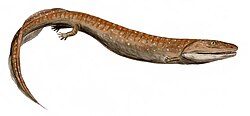| Devonosteus Temporal range: | |
|---|---|
| Scientific classification | |
| Domain: | Eukaryota |
| Kingdom: | Animalia |
| Phylum: | Chordata |
| Clade: | Sarcopterygii |
| Clade: | Tetrapodomorpha |
| Family: | † Tristichopteridae |
| Genus: | † Devonosteus Jaekel, 1927 |
| Species: | †D. proteus |
| Binomial name | |
| †Devonosteus proteus Jaekel, 1927 | |
Devonosteus is an extinct genus of prehistoric marine lobe-finned fish known from the Late Devonian. [1] It contains a single species, D. proteus from the late Frasnian of Wildungen, Germany. [2] [3] It has sometimes been considered a lungfish of the family Holodontidae, but this remains uncertain as the original specimen may be lost. [4] [5] Alternatively, it may be a tristichopterid, a type of basal tetrapodomorph. [6]





